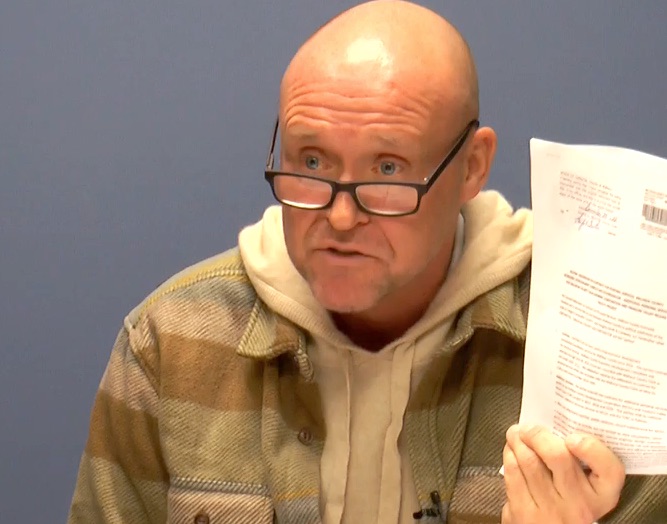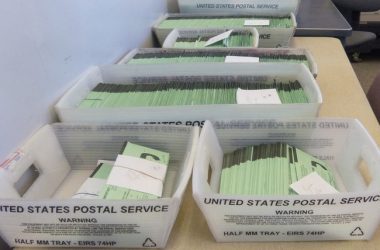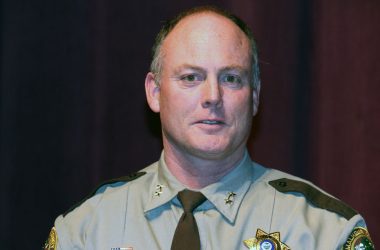The manufacturer’s pitch appealed to officials at Treasure Valley Reload Center.
It was spring 2022 and the project was running short of money.
Use our special construction fabric, the company said, and contractors can cut in half the depth of rock needed as part of the rail bed.
The reload team then led by project manager Greg Smith bit.
But now more than three miles of rail installed with the fabric now may have to be torn up in the latest crisis hitting Malheur County Development Corp.
The development company is scrambling to appease its crucial partner, Union Pacific Railroad. They believe a new study will convince the railroad to accept the tracks as built, not as originally designed.
Union Pacific is king in the project. Without its say, no rail car can pull off the mainline into the Nyssa depot to load onions. And Union Pacific is questioning the major change in rail construction, one it apparently wasn’t consulted about.
“While Union Pacific approved the initial design for this project, the completed work differs and further analysis is now required to determine whether safety and operational requirements have been met,” said Mike Jaixen, Union Pacific senior communications manager.
The railroad is known for being forceful in protecting its track, meticulous about ensuring designs will support its rail traffic.
“I have been trying to obtain schedules and material onsite dates, compaction test for the dirt work and when it will be completed for this project and have been getting absolutely no response.”
–Railroad representative email to engineers
An investigation by the Enterprise found that key construction steps weren’t followed, engineers were unclear who was doing what, and that after-the-fact approval is the only thing saving project leaders from a wholesale rebuild. The investigation relied on hundreds of pages of emails, engineering plans, contracts and internal development company records dating back to 2019.
A full accounting wasn’t possible because prime players are staying silent. They ignored repeated questions delivered in writing by the Enterprise in recent weeks.
Officials at RailPros, the Texas-based engineering firm in charge of designing the Nyssa track system, didn’t respond to written questions. They also didn’t respond to excerpts of this report provided to them to ensure accuracy. The company so far has been paid $328,967 in public money.
Officials at R6 Contracting of Union didn’t respond to written questions. They also didn’t respond to excerpts of this report provided to them to ensure accuracy. The company received $15.8 million in public money for project work including the rail beds.
Officials at Union Pacific didn’t respond to written questions. A spokesman provided a statement after the railroad was provided excerpts of this report to ensure accuracy. Union Pacific has received $2.6 million in public money for rail connections it has yet to install.
The lead engineering firm on the project, Anderson Perry & Associates of La Grande, has been paid $1.9 million so far to supervise construction. A company official said Anderson Perry did all it was supposed to, relying on assurances from RailPros that everything was in order.
Rail project stalled
The track issue would be more significant had Treasure Valley Reload Center proceeded on schedule. By now, it was supposed to be moving tons of onions out of Nyssa. For now, though, it doesn’t need the rail. The project has been mothballed, beset by cost overruns, a state decision to suspend funding, and the departure of the one company that officials counted on to run the Nyssa depot.
The track debacle is rooted in decisions made by project leaders more than a year ago, in April 2022.
Smith, who quit the project last February, had touted as a signature accomplishment the industrial track agreement, a contract between Malheur County Development Corp. and Union Pacific.
One provision said that the county-created development company “must in all events obtain railroad’s prior written approval of the plans for any proposed track changes.” The agreement included engineering designs for the track, approved by all parties including the railroad.
The development company went through that change process as construction was to start. In fall 2021, a Union Pacific regional executive wrote to Smith confirming the railroad had received an “updated construction plan that reflects a change in the design” shifting the location of one rail spur.
The executive noted that the contract “was based on the prior approved construction planset” and “that any approved change in design” would require an updated plan to guide construction.
Union Pacific a month later sent notice that the rail spur change was “approved/accepted.”
The plans provided detailed construction information and requirements. Note 15 in that plan said: “No field changes will be permitted without direct written authorization from the owner, engineering and railroad representative.”
However, with construction underway starting in late 2021, Smith and his team realized there wasn’t enough money to pay for everything. To pare the project, Smith canceled construction of one rail spur.
The development company has no record that Union Pacific approved that. The rail spur, in fact, was crucial to depot operations and Smith’s decision had to be reversed later at a cost of more than $2 million.



Greg Smith, left, former project manager; Brad Baird, lead engineer; Shawn Marshall, rail engineer.
At the same time, another cost-cutting move came to life.
Under the approved plans, construction crews were to grade the rail track course and then put on one foot of gravel – subballast. This layer helps stabilize rail tracks by dampening vibrations, spreading the rail car load and draining water away from rails and ties.
The importance of this layer is clear from the engineering plans.
“Subballast must be approved by railroad prior to installation of rail, ties” and other elements, according to Note 22 of the approved plans.
Track idea emerges
Notes from a construction team meeting of April 7, 2022, show discussion about changing the one foot of subballast to a combination of six inches of rock and a layer of geogrid.
Geogrid is a flexible but tough sheeting made of interlocking fabric blocks. The contractor bought one form of the geogrid from Tensar, the manufacturer, to help the construction get across saturated ground.
A Tensar engineer suggested their product could be put to another use as well.
“The subballast section could be reduced from 12” to 6” thick with the geogrid would increase the stiffness of the subballast, which would increase the bearing capacity of the railroad section,” the engineer wrote in an April 8, 2022, email.
That triggered an email conversation between Andy Lindsey, an engineer with Anderson Perry, and with Shawn Marshall, an engineer with RailPros. RailPros was in charge of engineering the track system.
Lindsey passed along Tensar’s suggestion.
“They have recommended using an additional layer of geogrid below the subballast which would allow us to reduce from 12” to 6”. This would result in significant cost savings to the project, in the neighborhood of $200,000,” according to Lindsey’s April 13 email. “Please take a look and let us know if this is something you would be comfortable with and what you would need to do to get this approved.”
Brad Baird, lead project engineer for Anderson Perry, said in an interview that it was up to RailPros to get the railroad’s approval to change the subballast. Marshall and Ken Koff, Railpros president, didn’t respond to questions.
But Marshall appeared to give the greenlight to make the change.
“Yeah we rely on the geotech to let us know if we need 12” subballast or 6” subballast. I trust Tensar’s recommendations,” he said in an April 14, 2022, email. His message made no mention of Union Pacific.
The person records show was monitoring the reload project for Union Pacific soon complained he wasn’t getting needed information. Terrel Anderson was employed by RailPros but reported to the railroad.
“My responsibility is to UPRR,” Anderson wrote on June 17, 2022. “This includes obtaining approvals, submittals, inspections, schedules, and making arrangements for the railroad crews to schedule their portion of the work.”
He said in his email to an Anderson Perry engineer, “I have been trying to obtain schedules and material onsite dates, compaction test for the dirt work and when it will be completed for this project and have been getting absolutely no response.”
Seeking information
A month later, he wrote another email to Anderson Perry seeking project details.
“This is critical information that I have been requesting for a while now,” Anderson wrote.
Marshall, the project lead for RailPros, forwarded the complaint to Smith and Baird.
In the ensuing weeks, R6 Contracting put down the subballast layer using Tensar’s geogrid material.
Tensar and R6 officials wouldn’t answer how much Tensar was paid for the extra geogrid.
But the lack of Union Pacific’s approval became clear by August 2022.
Marshall of RailPros sent to Anderson Perry the revised construction drawings showing the changed subballast design.
“Let me know if this works and I’ll send over to Terrel with UPRR to make sure they’re good with the change,” Marshall wrote.
Two weeks later, Marshall was still seeking Anderson Perry’s help.
“I need to submit something to UPRR showing that 6” of subballast over geogrid meets the UPRR requirements. Can you get something from your geotech that we can submit?” Marshall wrote.
Lindsey of Anderson Perry replied with an earlier email from Tensar recommending the change. He said the project team “proceeded with this change based on your concurrence, so hopefully there are no issues with UP.”
Marshall replied without addressing the railroad matter, writing, “I need something like a memo or report that I can upload to the UPRR submittal database.”
A week later, Marshall again pressed for information, writing in an email, “Any update on getting us something we can submit to UPRR?”
By then, virtually all the subballast layer had been installed with the revised, not the railroad-approved, design.
Baird later advised the board of the development company that the railroad had inspected and approved what had been built. He repeated that in a recent interview with the Enterprise.
To back that up, Baird provided a “Project Observation Report” from his team.
According to the Aug. 29, 2022, report, an Anderson Perry worker reported that “Rick Mathews the Rep for the Union Pacific RR made drove [sic] to the site to check subballast grade for track A, B, and D.”
Conflicting accounts
But questions have emerged over who Rick Mathews was representing.
Baird said that Rick Mathews was employed by RailPros but had been designated by Union Pacific to be its on-scene agent to approve construction. That designation, Baird said, came from Terrel Anderson, the one person with ultimate authority over the reload track construction for the railroad.
“He is the official UPRR person for inspections,” Baird wrote in a recent email.
But Marshall of RailPros disputed that in an email last month to the development company.
He said Mathews served as his company’s construction manager and “he represents MCDC, not UPRR.”
Officials from Union Pacific and RailPros didn’t respond to written questions about the nature of Mathews’ role or authority.
But Union Pacific still needed documentation about the rail bed changes, according to emails.
On Sept. 7, 2022, a second Tensar engineer shared with project officials his nine-page report justifying the rail bed change to use his company’s material.
But the report carried an important caveat.
“A qualified and experienced geotechnical engineer engaged by the site owner or other designated party should evaluate and confirm these and other considerations. Tensar has not been engaged in such role,” the report said.
That meant the seller of the geogrid was advising Malheur County Development Corp. to get an outside expert review.
That didn’t happen.
Manufacturer advice ignored
Instead, the two engineering firms sparred through emails, with RailPros seeking something in writing from Anderson Perry that recommended, after the fact, the design change. Anderson Perry shot back that it was RailPros’ duty since the subballast construction “was designed by RailPros.”
It’s not clear from available records how well Smith was tracking this issue – or its implications. Smith didn’t respond to written questions about the matter.
Whatever the internal disputes, the construction crews returned to Nyssa last spring to lay down the rail bed for a fourth rail spur. That was constructed with the same controversial.
Again, Anderson Perry relied on the inspection by Rick Mathews for assurance the construction met with railroad approval. The Project Observation Report dated May 22, 2023, said that “Rick Mathews representative of the UPRR made a site visit to approve the Subgrade and Subballast grade” for what was known as Track C.
The controversy broke into the open in Baird’s standard report at the Sept. 5 meeting of the development company board.
The railroad was scheduled to connect its mainline to the reload center when it sought documentation about the subballast construction.
“They just keep asking questions about this subballast revision,” Baird told the board. “We just keep going back and forth on getting their final approval on that. We’re not sure where it’s gonna go at this point.”
Shawna Peterson, who took over development company executive director last March, said she could find no authorization from the company for rail bed design change as required by the plans. She also said “direct written authorization” from Union Pacific doesn’t appear “in any meeting materials, minutes or other documents in the files I have.”
Baird told the development company board that a few hundred yards of track bed near the mainline may have to be done over to satisfy Union Pacific. He said the cost would be minimal.
Questioned, he said “I can’t imagine” the railroad would require reconstruction of track finished on the rest of the project.
Besides, he said the new design was just as good as the original.
“This is not a big deal,” Baird said in an interview.
He told the board that RailPros all along had the job of getting railroad approval for the change in track bed.
“I’m not so sure they got railroad approval,” Baird said. “We didn’t approve it. We asked them to get it blessed.”
RailPros executives didn’t respond to questions about Baird’s statements.
Peterson said that while replacing all the track remains a possibility, “I’m getting constant reassurance that that’s an unlikely scenario.”
Peterson told the board earlier this month that she was banking on getting an independent engineer’s report confirming that the revised rail bed meets Union Pacific’s needs.
She speculated such a report could cost $40,000 and take several months to complete.
But that move is on hold.
While Baird has maintained that RailPros was responsible for railroad approval, he’s stepped in to resolve the track dispute.
He said in an email Thursday, Oct. 5, to the development company board that he was working with Tensar to provide a technical report for Union Pacific.
His email didn’t address Tensar’s advice a year ago that the development company get an outside review.
“We collectively are targeting next week to wrap up the response to UPRR. We are expecting approval after providing this information to UPRR,” Baird wrote.
Contact Editor Les Zaitz: [email protected].
PREVIOUS COVERAGE:
Reset is intended to give fresh life and bigger role to Nyssa rail project
As last contractor departs, unanswered questions remain regarding rail reload center
State will not enforce deadlines on rail reload project, waiting for new plan
State halts funding for Treasure Valley Reload Center, imposes conditions
NEWS TIP? Send an email to [email protected].
SUPPORT OUR WORK – The Malheur Enterprise delivers quality local journalism – fair and accurate. You can read it any hour, any day with a digital subscription. Read it on your phone, your Tablet, your home computer. Click subscribe – $7.50 a month.




